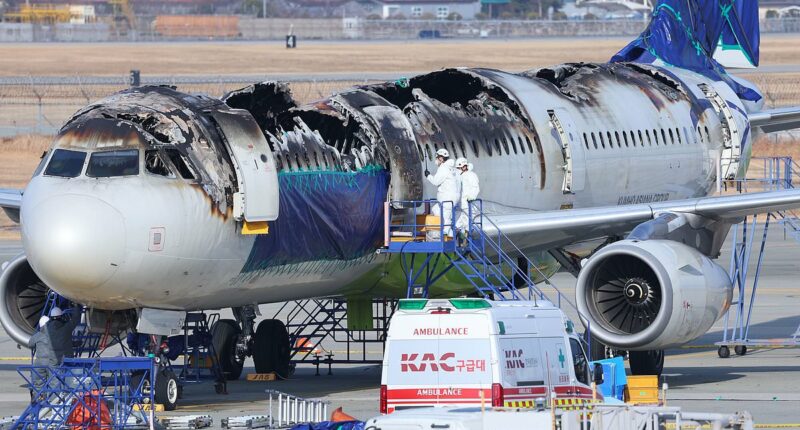Share this @internewscast.com
It was supposed to be a routine overnight flight across the Atlantic.
Rather, passengers on a crowded KLM Boeing 777 flying from São Paulo to Amsterdam on August 6 experienced smoke filling the cabin, panic setting in, and faced the fear of a potential catastrophe — all due to a portable phone charger that detonated mid-flight.
Brazilian sports writer Simone Malagoli, who was among the travelers, says the cabin was silent as most passengers slept. Then — chaos.
‘I almost messaged my parents to say goodbye because I genuinely believed I was about to die,’ she posted on Instagram, accompanied by alarming footage of smoke circulating through the plane.
The charger, tucked inside a passenger’s backpack, caught fire midway over the Atlantic, some four hours from landing.
Crew members swiftly reacted, extinguishing the fire with extinguishers. They identified the battery-powered gadget as the culprit, despite it not being connected to a power outlet at the moment.
This frightening incident is part of an increase in fires related to lithium batteries on airplanes — a concern some aviation specialists warn may be ignored by the airline sector.
In just July, a Virgin Australia flight experienced an overhead bin ignite, and a Delta flight had to make an emergency landing in Florida when a passenger’s power bank combusted during the flight.

The burned out wreck of an Air Busan plane in January sent shockwaves around the world about the threat of power bank fires

Two people were injured when a power bank caught fire aboard this Taiwan to Singapore flight in January 2023
In January, a power bank incinerated an entire Air Busan plane before takeoff in South Korea.
The fire spread throughout the cabin after the battery was compressed in the overhead compartment. The aircraft was destroyed, though fortunately, all 169 passengers along with seven crew members evacuated in time.
At the center of the crisis is the ubiquitous power bank — used by nearly one in three US travelers.
These palm-sized chargers are powered by lithium-ion batteries, the same high-density cells found in laptops, e-cigarettes, headphones, and smartphones.
But these batteries can overheat, explode, or catch fire because of overcharging, exposure to heat or water, physical damage, and manufacturing defects.
The result is ‘thermal runaway’, a self-perpetuating chain reaction that sends the battery into meltdown.
An average of two thermal runaway incidents occurred each week on passenger flights in 2024, according to safety experts UL Standards & Engagement (ULSE).
Two-thirds of them occurred during takeoff, cruising, or landing — when the risks of a catastrophe are inherently higher.
Despite mounting risks, experts say the airline industry is failing to respond adequately.
A shocking two in five travelers admit to packing lithium devices in their checked baggage — a breach of airline rules that can cause fires in the cargo hold can go undetected until it’s too late.

Simone Malagoli said she considered reaching out to her parents back home in Brazil because she was not sure the KLM Boeing 777-300 was going to make it to Amsterdam moments after a passenger’s cell phone charger got caught on fire

For many travellers, the portable power bank is a must-have item for keeping devices powered for the long-haul

Safety incidents are increasing as passengers bring more chargeable devices onto planes
Many battery fires start in overhead compartments, where crew cannot easily reach or remove burning items.
Yet overhead storage remains a popular spot for power banks, with 29 percent of travelers stashing them there, often unknowingly breaking airline safety rules.
Even worse, 30 percent of passengers say no one asked about lithium batteries when they gate-checked their bags — leaving flammable devices in the hold without anyone knowing.
Keith Tonkin, the boss of the Australian consultancy Aviation Projects, says the devices can be a recipe for disaster.
‘If there is a fire, you’d rather have it in cabin than checked baggage,’ he recently told the New York Times.
‘And you’d rather have it closer to a person rather than in the overhead bin, where it’s more difficult to get it out and manage the fire.’
ULSE safety researchers say airlines have been ‘too narrow’ in their response to date.
A handful have upped restrictions on power banks. What’s needed, they say, is a system-wide fix, with more crew training, tighter baggage handling, and much stronger public awareness.
Some international airlines have stepped up.
South Korea now bans charging devices from overhead bins.
Taiwan’s EVA Air, Singapore Airlines, Thai Airways, and others prohibit charging altogether — but still allow power banks to be stored above.

Experts say battery-making factories are poorly regulated and safety standards vary enormously

A battery fire on a flight from San Diego to Newark forced this plane to return to the terminal shortly after takeoff

Vapes, e-cigarettes and power banks are the most problematic items brought on to planes
Japan Airlines and All Nippon Airways have completely banned batteries from overhead compartments.
Southwest Airlines is the only major US airline to ban in-bin charging.
Ryanair tells flyers to remove batteries before stowing luggage. Emirates will ban the use of power banks aboard its flights, and limit passengers to bringing one device only the plane, from October 1.
But for most major carriers, including Delta, United, and American, portable chargers are not restricted for carry on.
The FAA has only focused on reinforcing existing rules, not further restricting power banks.
Despite repeated warnings from engineers and flight safety analysts, industry response has been alarmingly slow and inconsistent.
Airline safety chiefs are understood to be reluctant to further restrict passengers who already feel burdened by an abundance of rules.
Cabin crews are armed with thermal containment bags and trained to manage in-flight fires.
But with up to 300 passengers per flight, each carrying four lithium-powered gadgets, the risk is growing exponentially.
According to ULSE, that adds up to nearly 2,200 rechargeable batteries aboard a big plane.
Vapes — carried by just 10 percent of travelers — cause 28 percent of onboard battery fires. Portable chargers come next.

A fire from this portable charger wedged in a seat forced a Virgin Atlantic Flight to make an emergency landing at Boston Logan International Airport

ULSE says passengers need to learn much more about the dangers of portable chargers
As planes fill up with gadgets and chargers, and as more bags are gate-checked without screening, aviation experts warn that a catastrophic midair fire is no longer a question of ‘if’ — but ‘when’.
Hong Kong aviation expert Warren Chim Wing-nin urges passengers to follow the rules, and to be choosy when buying electrical goods from an industry that is often poorly regulated.
‘If it’s not a good product, the risk will be much higher,’ he told the South China Morning Post.
Until airlines and regulators act — your seatmate’s charger could be your biggest in-flight danger.















